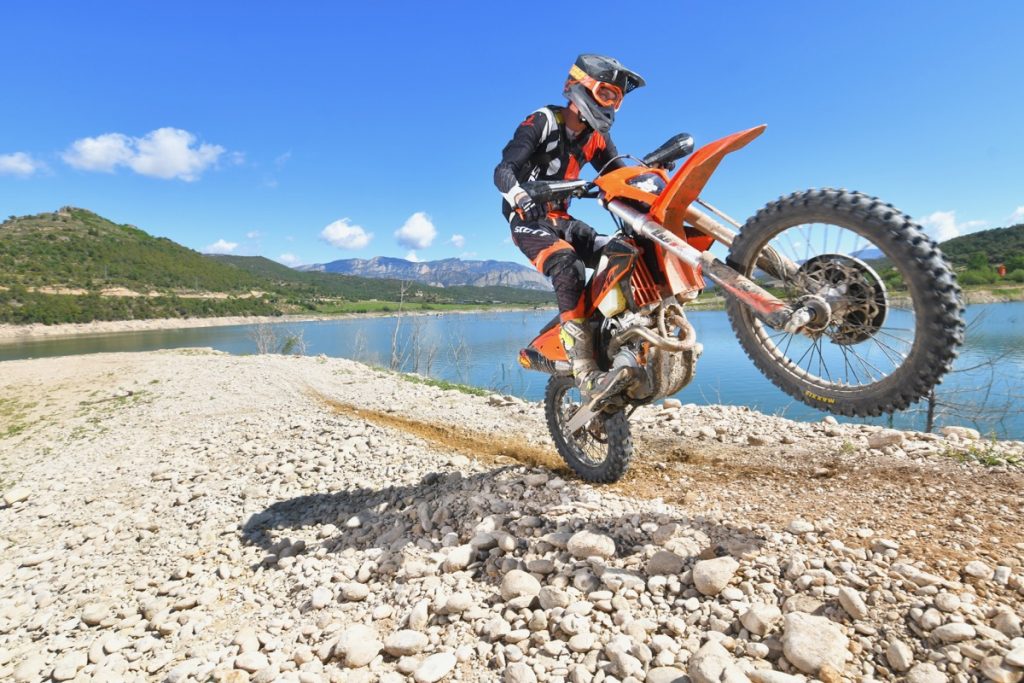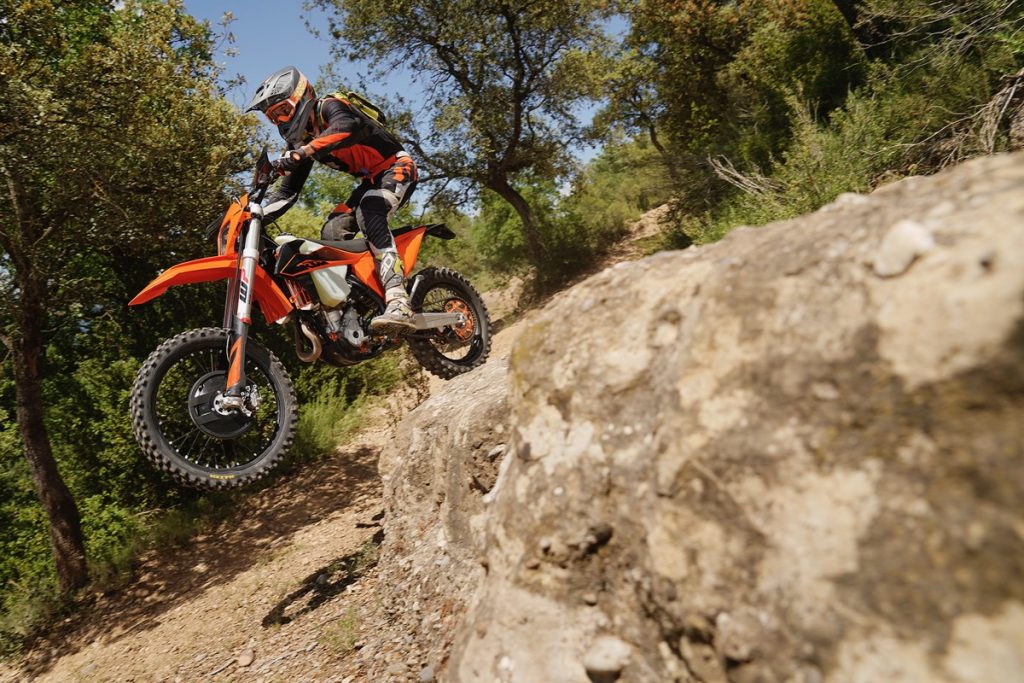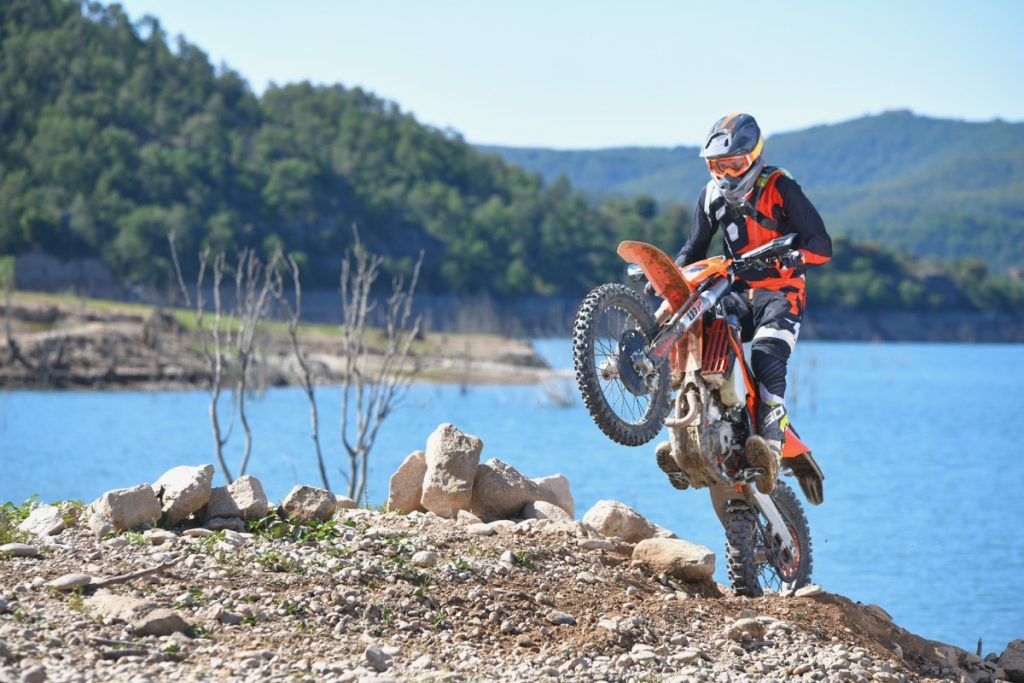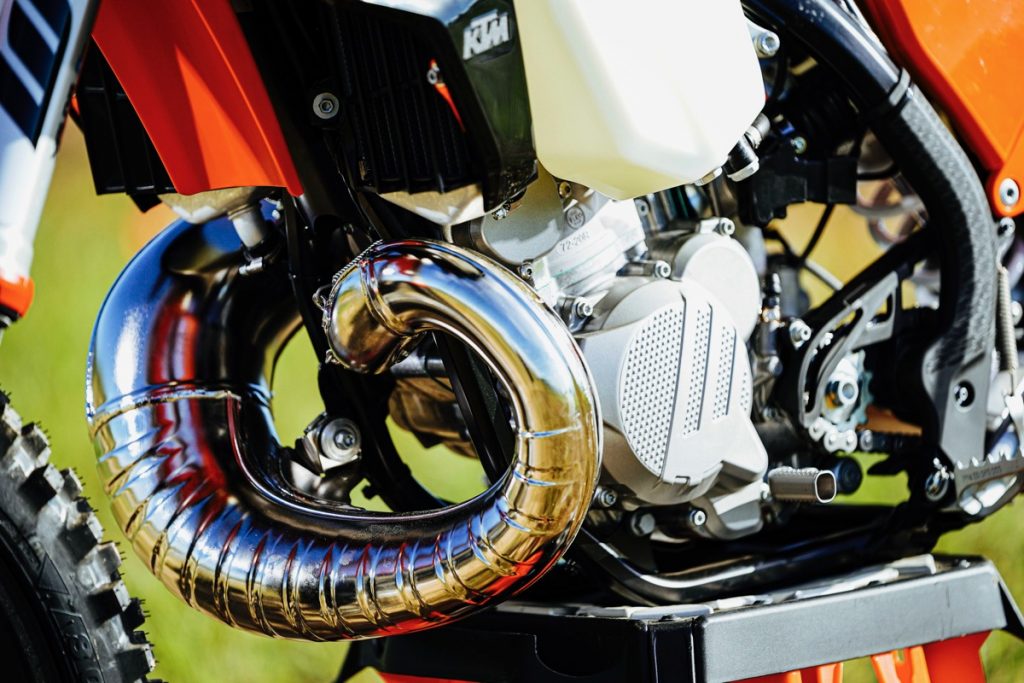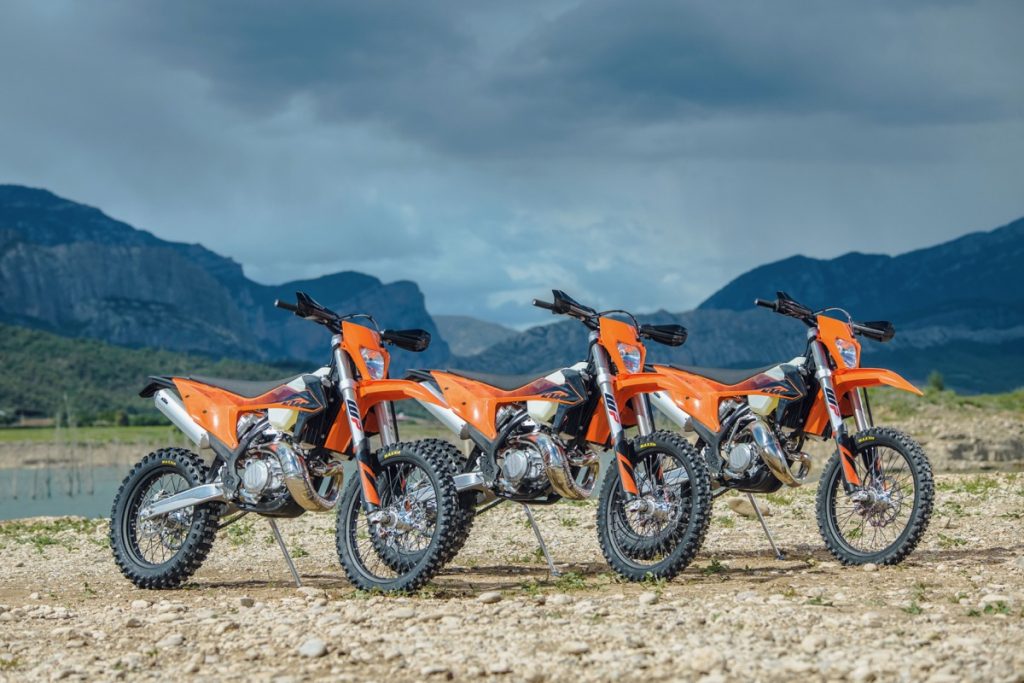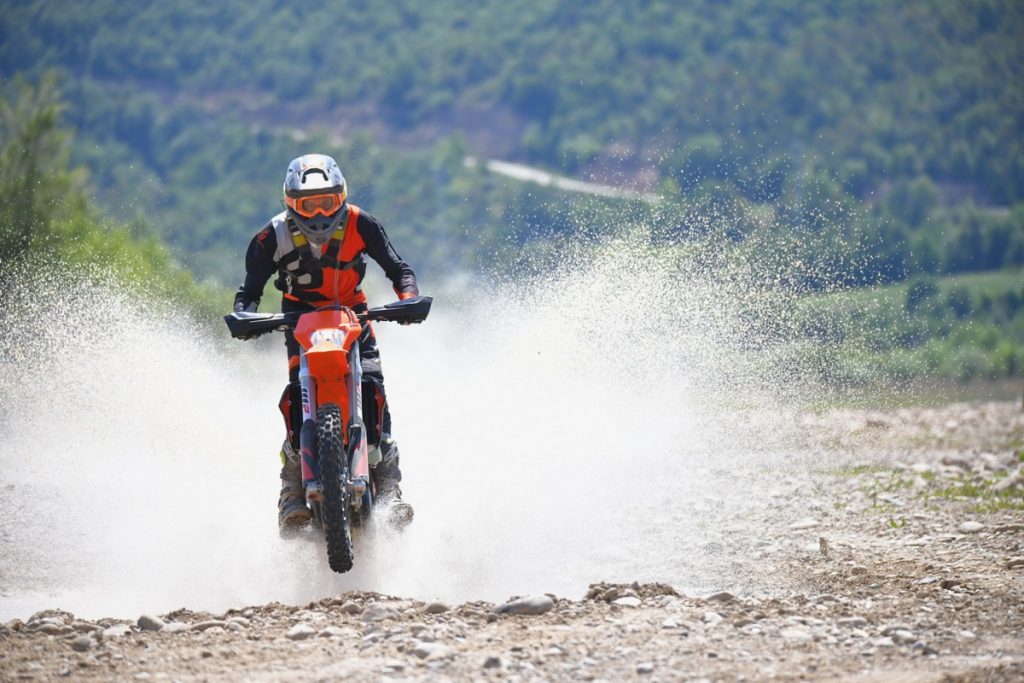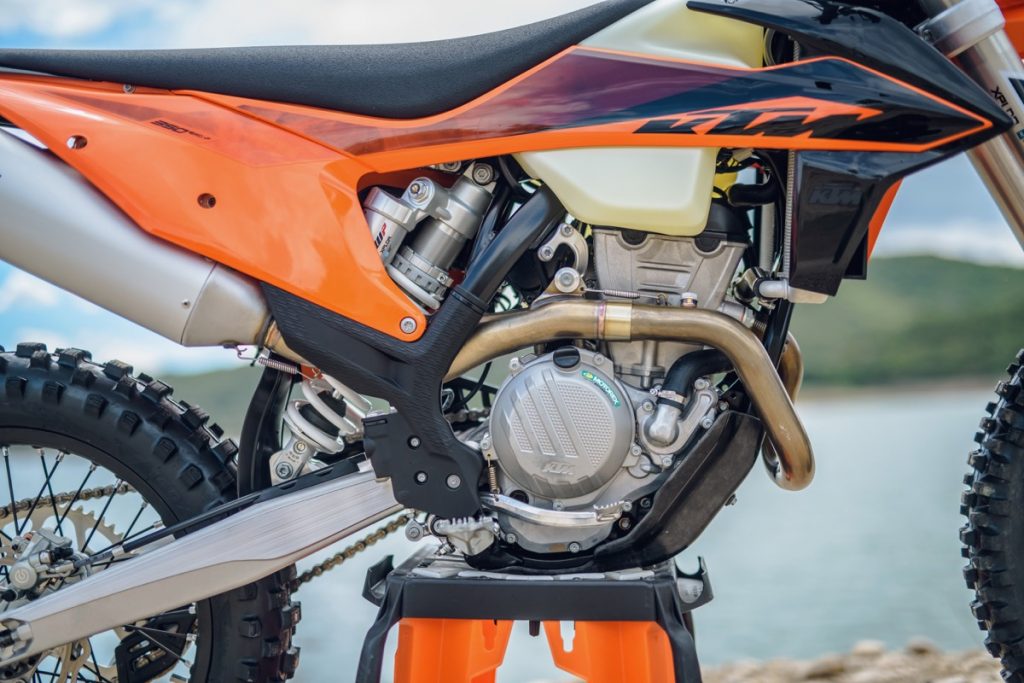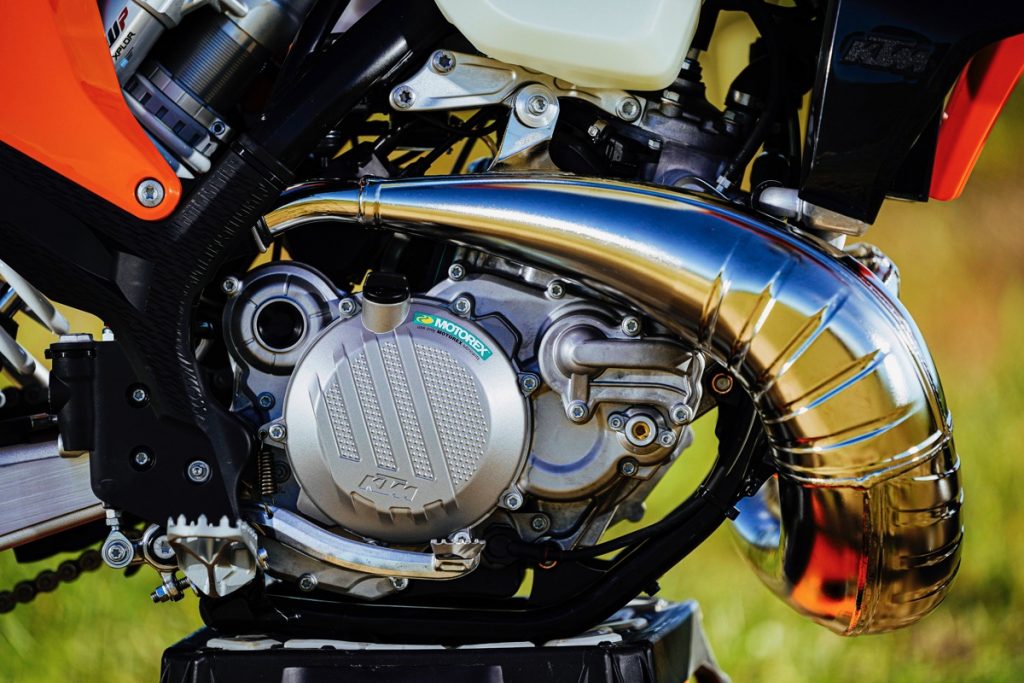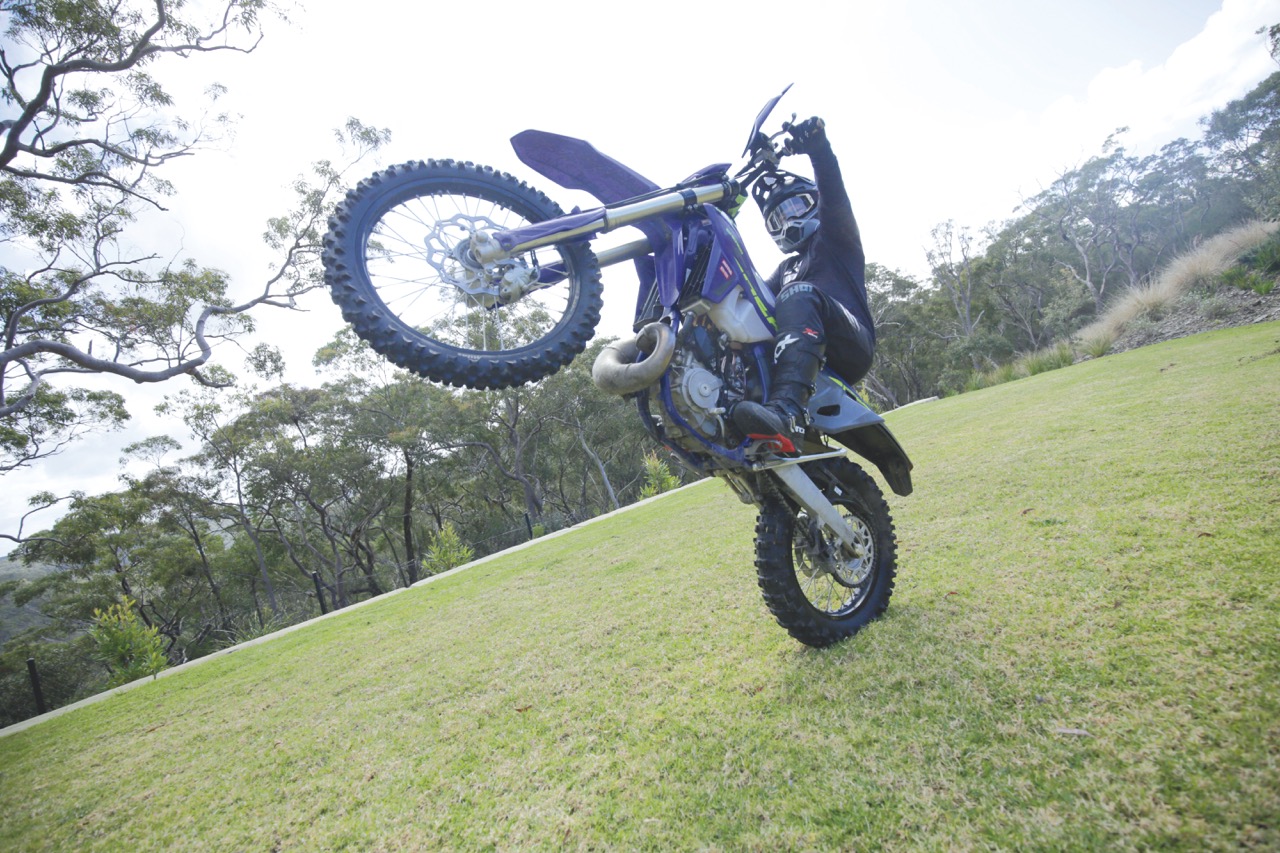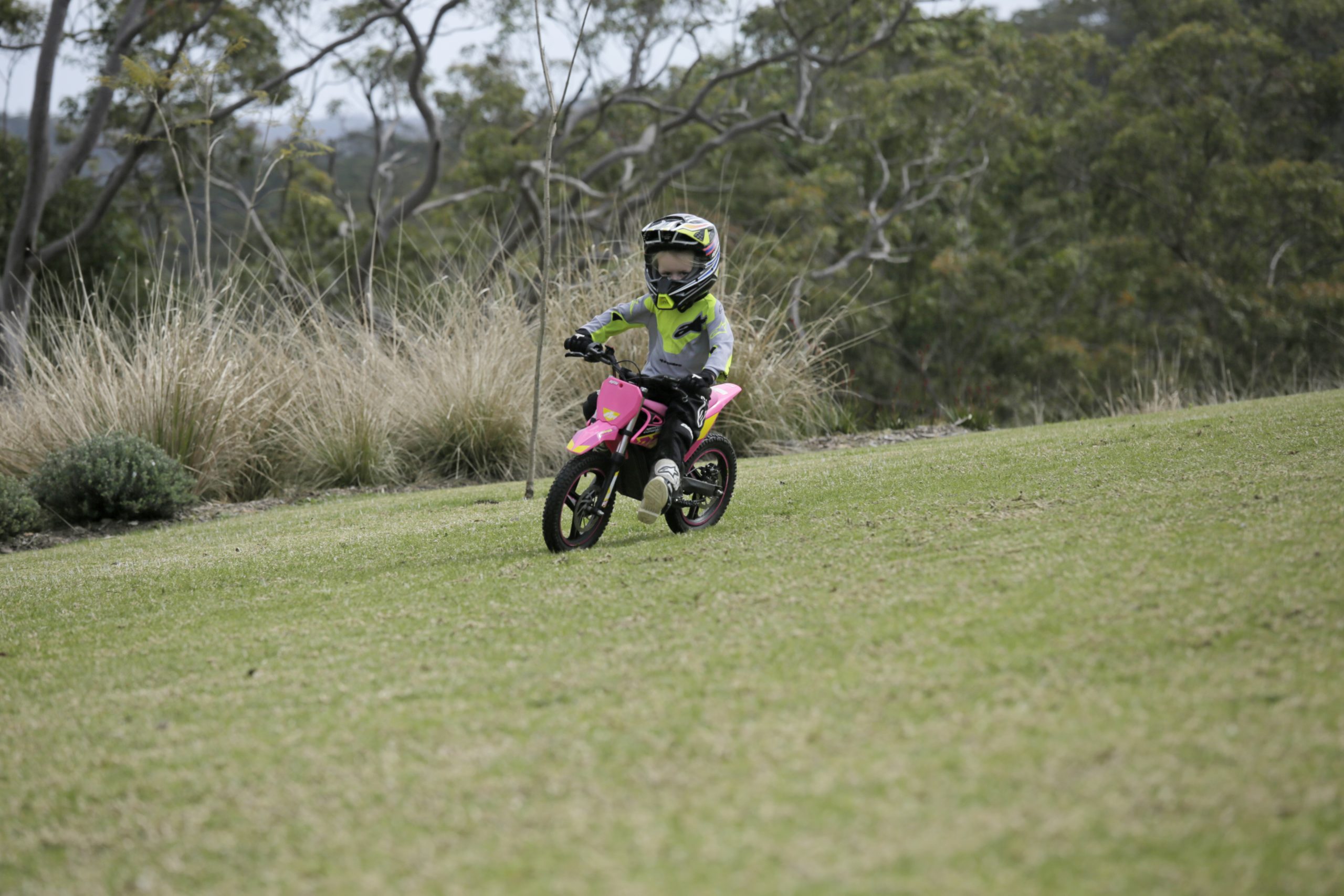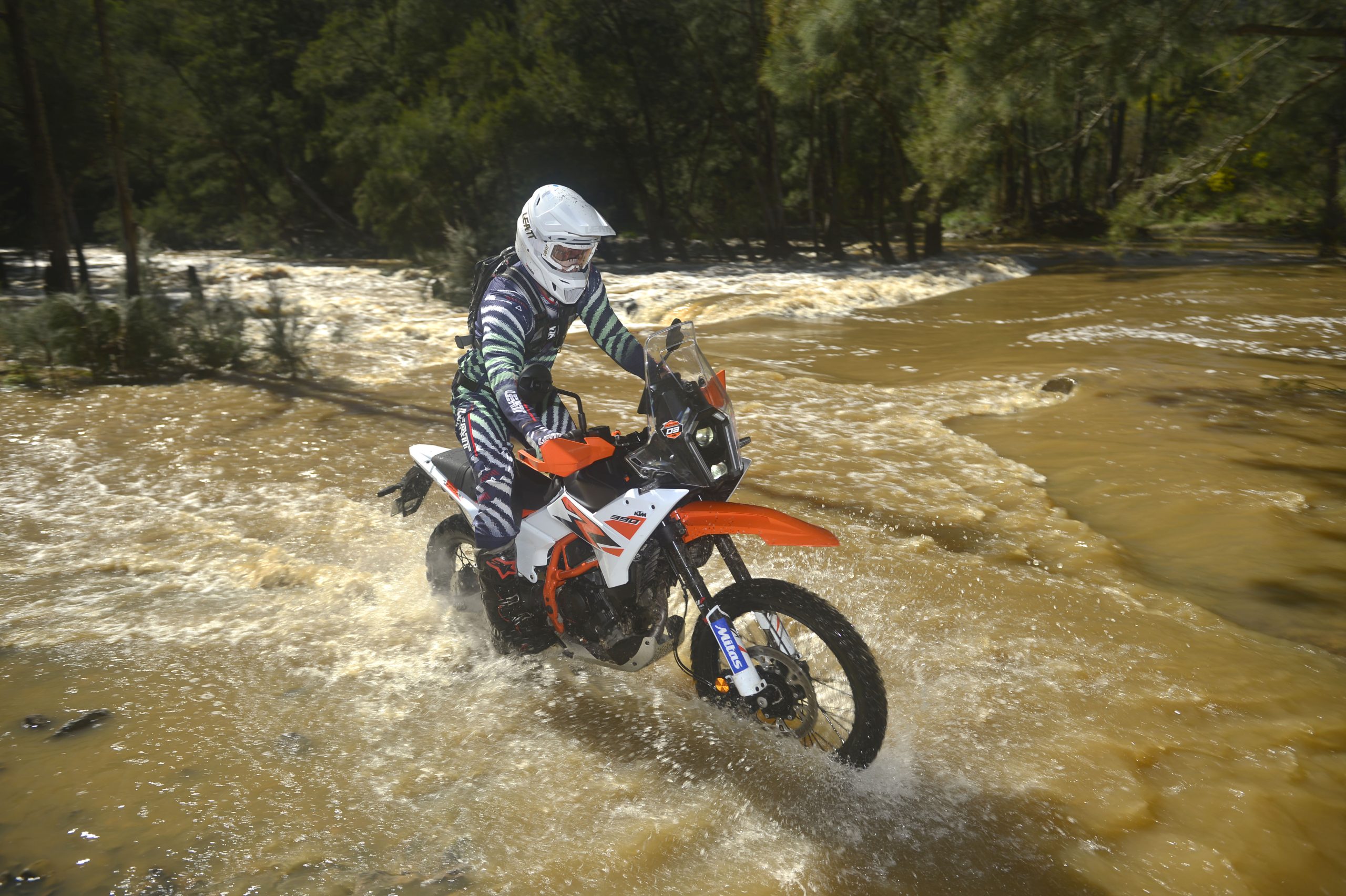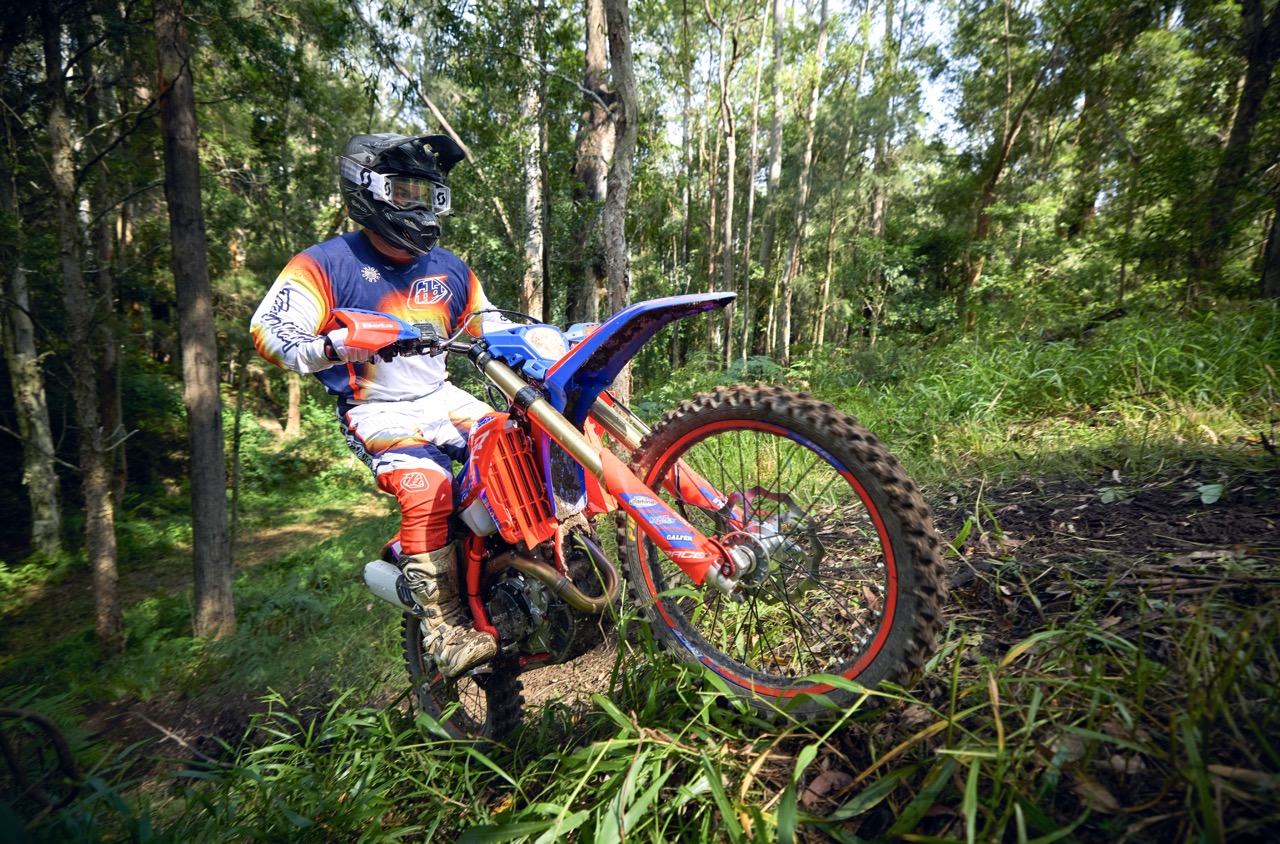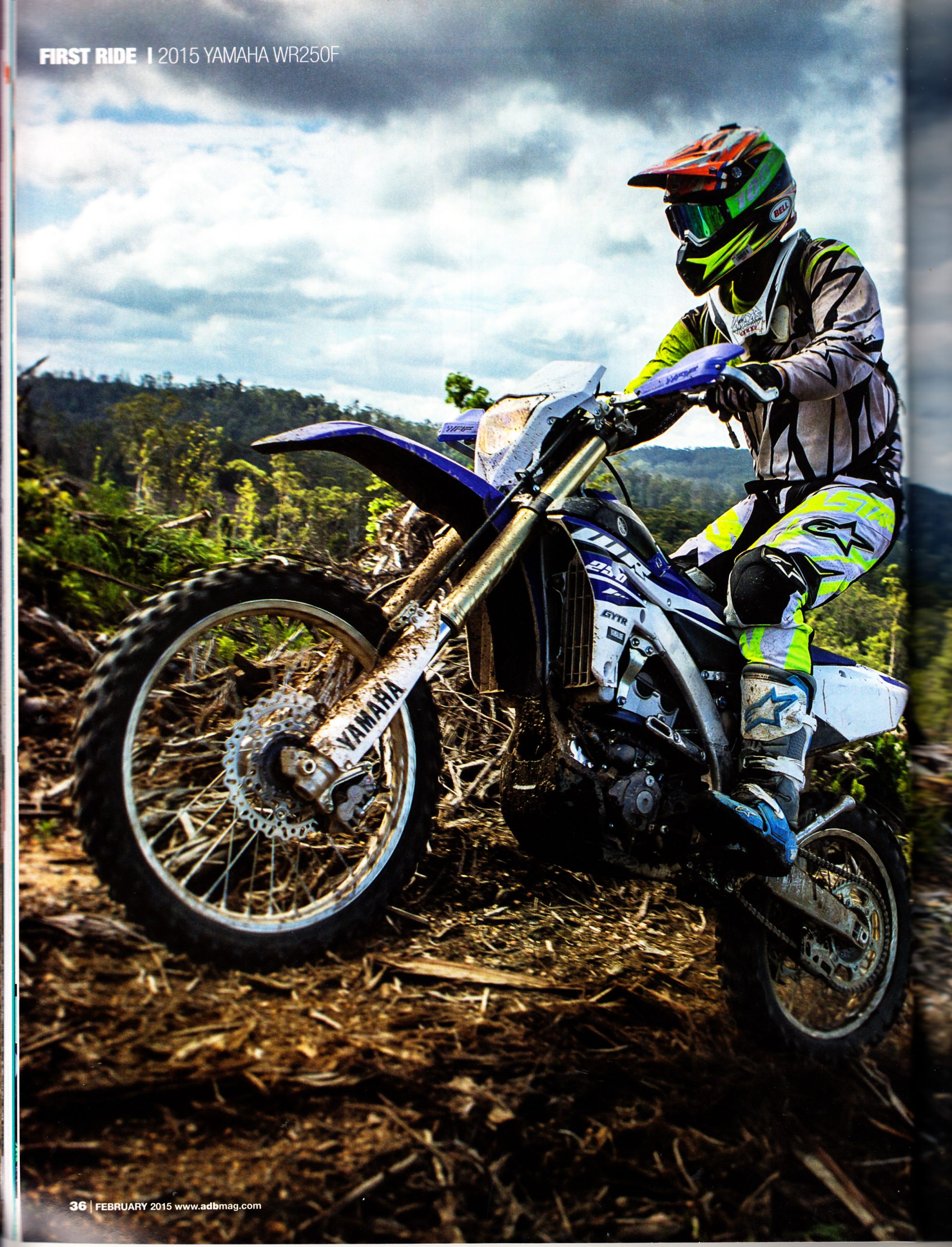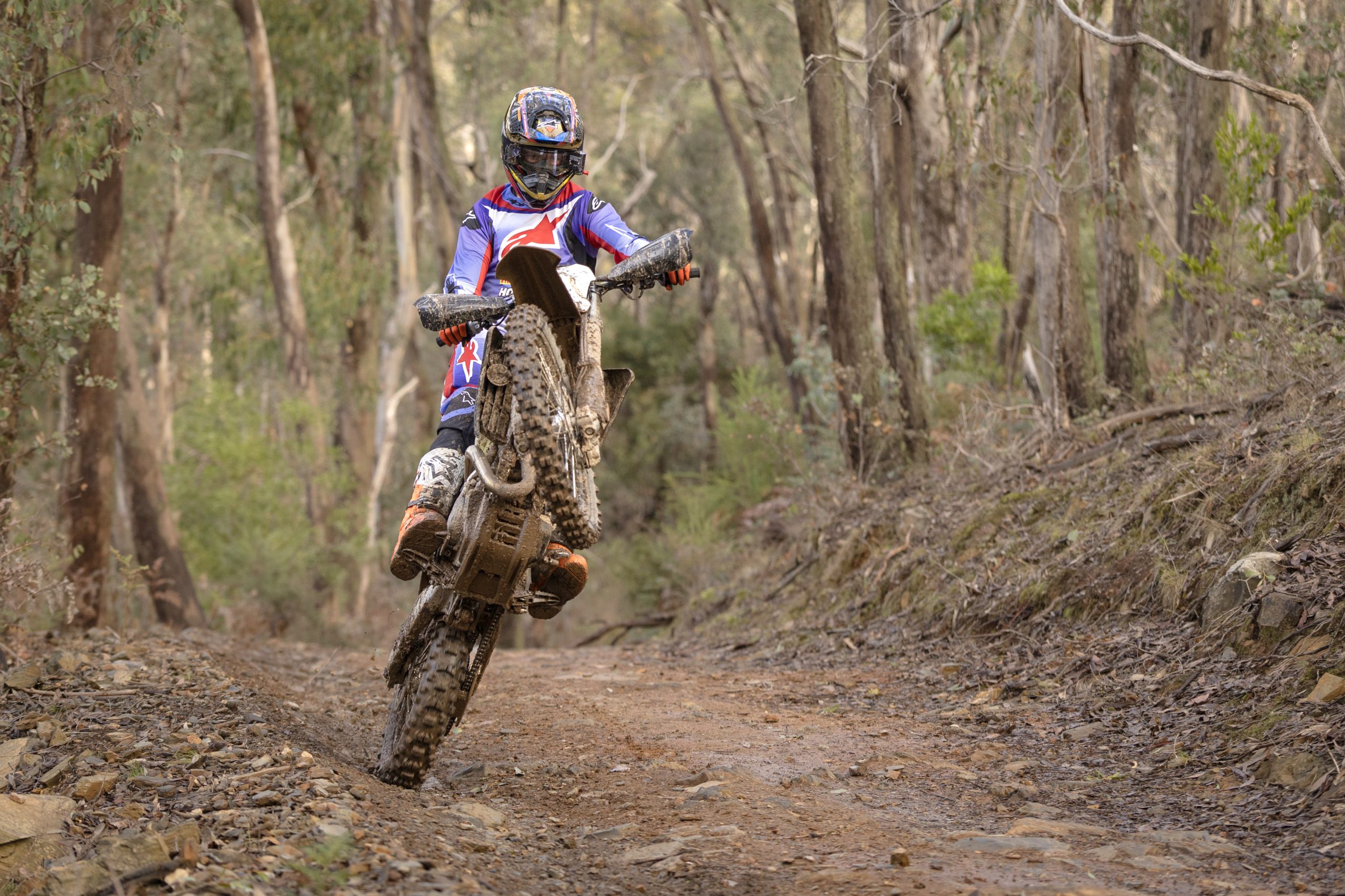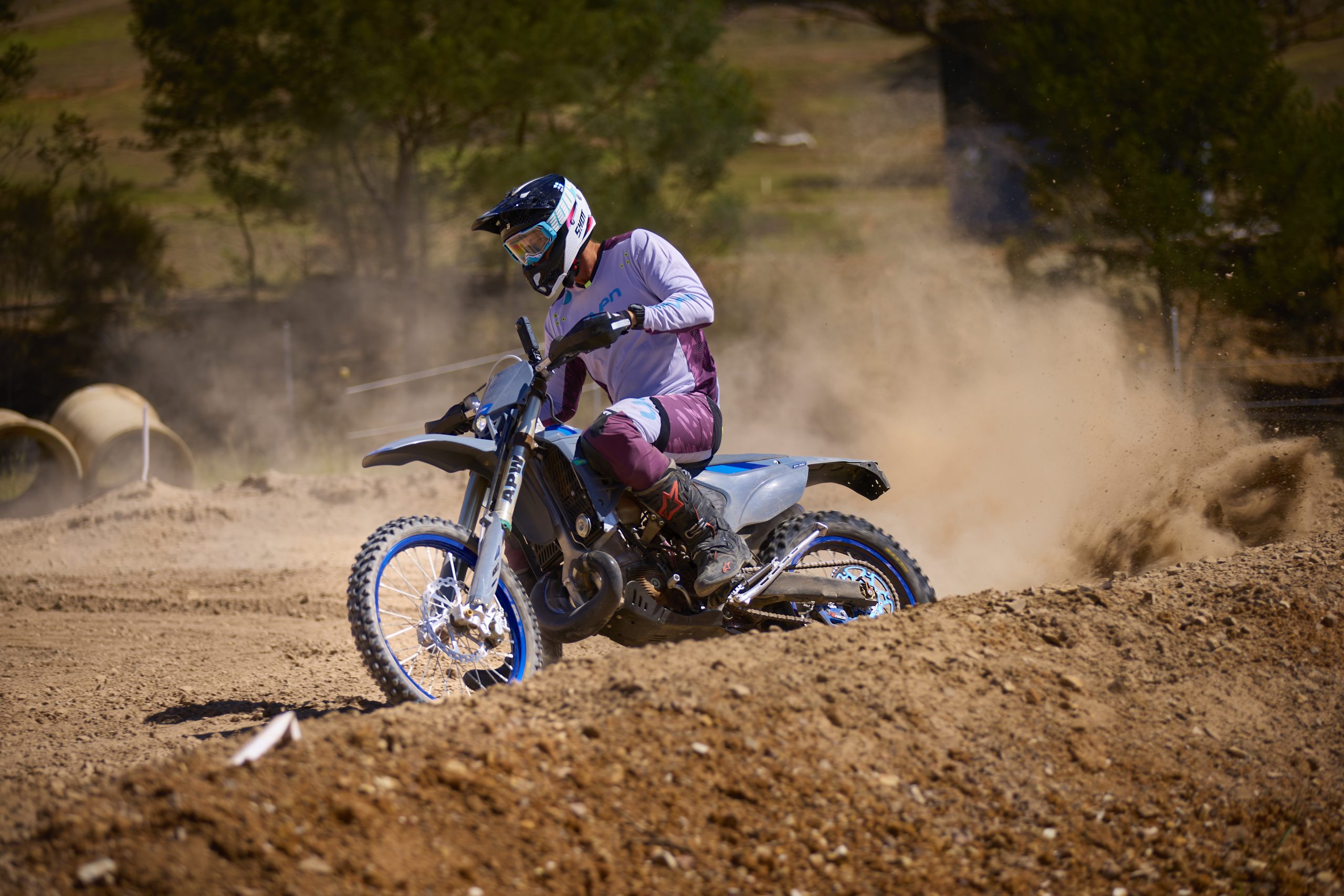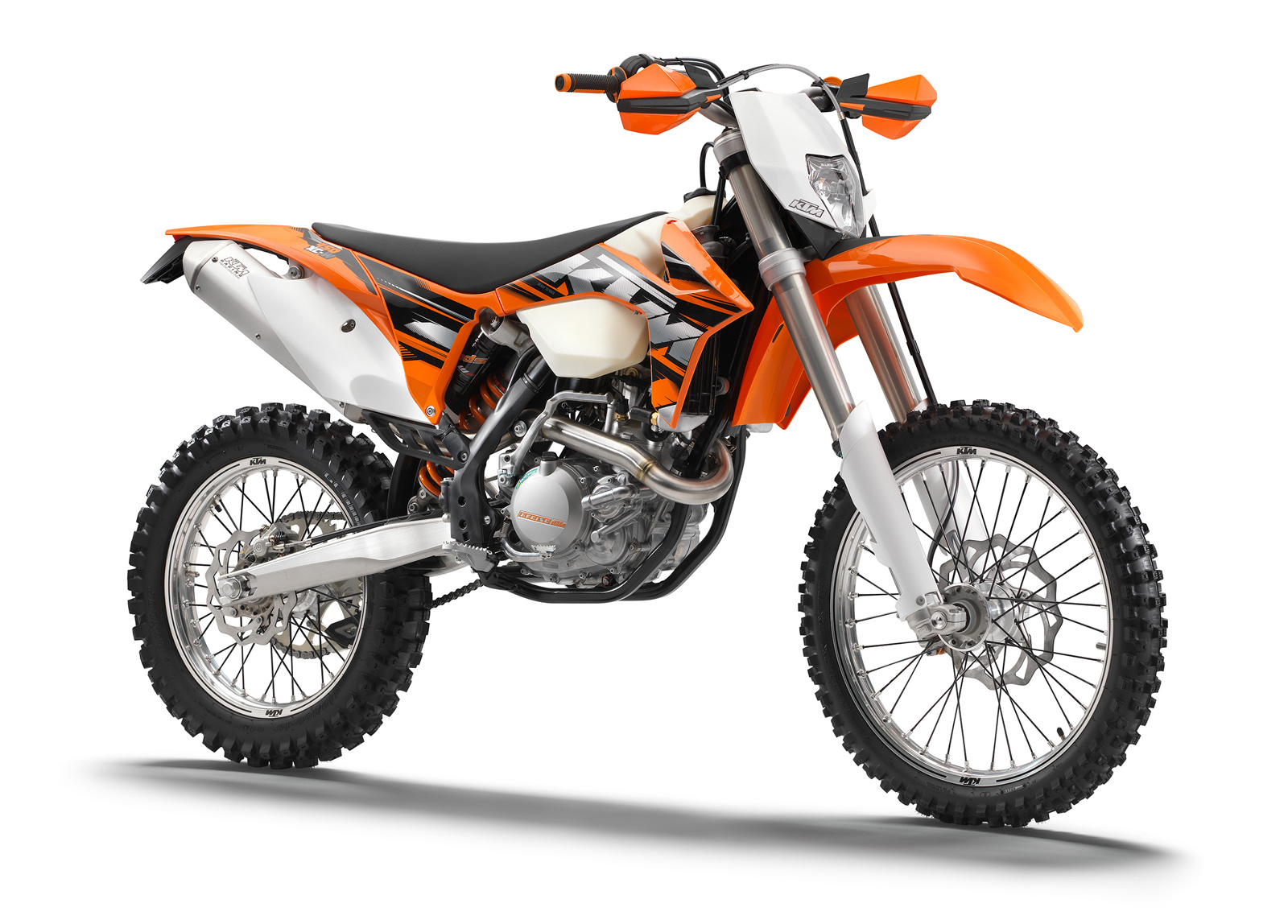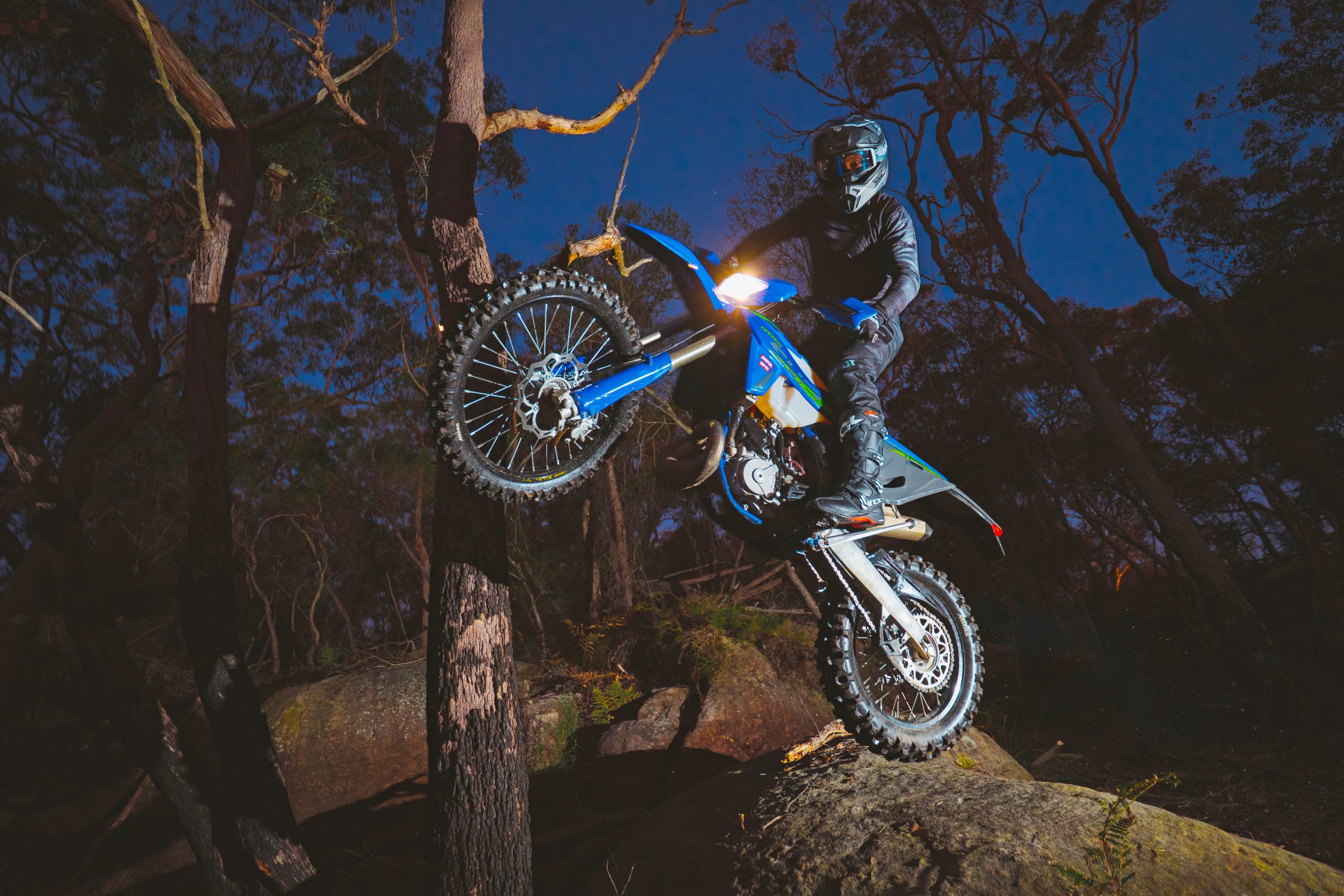It did beg the question though, how could KTM make its enduro range any better? Well, it did, but not through monumental changes. KTM knew it was onto a winner with last year’s models so the 2020 KTM range saw the Austrian’s focused on small changes.
The launch took place in Oliana, two and a half hours from Barcelona and our transfer came in the form of a 50-seater coach. With just four Aussie journos and Tam Paul from KTM Australia we had 10 seats each… After two-and-a-half terrifying hours of WRC-level driving, the bus dumped us on the edge of the Pyrenees Mountains at the Oliana WP Centre where the Katos were to be unveiled.
KTM knows how to make an entrance. They enlisted Taddy Blazusiak and Jonny Walker to ride a pair of 2020 EXCs onto centre stage. The new bikes certainly look different thanks to new graphics, new plastics and back-in-black frames but Senior Product Manager Off-Road Joachim Sauer wasted no time in explaining that KTM had focused on refining the existing platform.
“We set out to improve the overall performance. Not just the engine but the handling too, the overall performance of the bike should get better. That means reliability too, you can never have enough reliability.”
The 600-strong R&D team at KTM AG worked on refining almost every aspect of the platform but the update that caught most people’s attention involved the WP Xplor 48 fork. The separate-function unit has been criticised for being soft and, although that suits technical terrain, the fork had a tendency to dive under hard braking, especially downhill, which upset the balance of the bike.
KTM was paying attention and the MY20 fork comes with a new mid-valve piston to keep the front-end sitting higher in its stroke, maintaining the all-important front-rear balance. To retain the plush feel for average-size riders (75-85kg), a softer spring rate has been used. The Xplor PDS shock spring remains unchanged but the damping has been changed to match the front. The second piston in the shock has been reworked to provide stronger resistance to bottoming out.
Head of Enduro Platform Rupert Walkner said: “The idea was to bring the bike into a more balanced position. From our testing group, we worked out there was a little too much movement front to back and with more damping and softer springs in the fork we made the bike more in a constant balance.”
The suspension updates are noticeable as soon as you swing a leg over any bike in the range, but the larger four-strokes benefit the most. The greater inertia of the 450EXC-F and 500EXC-F punished the soft damping of the previous Xplor and would blow through the mid-stroke fairly easily. Now with the firmer damping, that unbalanced feeling has been greatly reduced.
Charging hard into corners and leaning on the front brake doesn’t upset the front-to-rear balance nearly as much and this has a huge impact on the overall performance of the bike. Cornering now feels more intuitive and faster, while braking is more effective. There were plenty of steep downhills on the test loop and they highlighted how well the fork stays in the upper part of the stroke, which is great if you need to get on the stoppers going downhill.
The shock was not only tweaked for better bottoming resistance, but for improved rear-wheel traction. WP achieved this by going softer on the low-speed compression damping and firmer on the high-speed. Over slow, slippery terrain the rear wheel was able to find traction in situations where it really shouldn’t, even on stock FIM tyres. Walkner explained that they wanted to tune the bike for extreme conditions and, with KTM now focusing on the World Enduro Super Series, this makes sense.
Despite the increased bottoming resistance in the shock and firmer damping in the fork, none of what made the Xplor fork great in slow, technical terrain has been lost. It still offers a very complaint ride that won’t beat you up during long days.
Small changes have made a huge different in the chassis characteristics. The geometry is unchanged but the flex has been changed. “The frame is not overall stiffer, but stiffer in specific directions,” Walkner said. “Torsional stiffness and longitudinal stiffness have been increased to create more precise handling and more traction on the front wheel.” The updates not only change the feel of the bike but less stress is put on the frame as it transitions through the flex pattern.
The headstay brackets are now all aluminium and softer than those found on the previous bikes. Softer mounts allow the engine to move more in the frame.
The movement is microscopic and you’ll never see the engine moving, but you feel it when you ride. A softer headstay allows for quicker direction changes from less rider input, crucial for weaving through trees.
Out on the test loop the 250 and 300EXC TPIs feel even more agile and changing direction through the trees is easier. It requires less effort through the footpegs to tip the bike into turns and a small blip of the throttle stands it back up ready for the next corner. The suspension changes and frame flex work well together to create a sharper handling bike that is still comfortable.
The four-strokes still take more effort to steer through tight tree-lined trails but you can feel the new frame working in your favour. I noticed the changes to the frame most when exiting corners, as the bike would stand up without much effort. On the grasstrack I found myself occasionally running wide out of ruts, especially on the larger-capacity bikes, because jet lag is a very real thing but also because mid-corner throttle would stand the bike up more than I anticipated. However, this is also due to the high bend of the stock handlebar, which can be addressed with a lower bend or moving the mounts to one of the other positions.
When I asked Walkner what he was proudest about on the 2020 KTMs, he was quick to answer. “My highlight for the two-strokes is the ambient-pressure sensor. It makes the engine much more quick to adjust to changes in air pressure. It makes life much easier because two-strokes are so sensitive to changes in air pressure and temperature.” Spoken like a true engineer. It’s one of the smallest changes on the two-strokes but one of the most important.
If you read Enduro Editor Geoff Braico’s write-up from the world launch of the 2018 Husqvarna fuel-injected two-strokes in Canada, you would know the TE300i and TE250i were almost crippled by the altitude. Braico noted that the EFI didn’t adjust well as he climbed and descended.
The ambient pressure sensor addresses this. The device feeds the ECU air pressure information so it can adjust the air/fuel ratio. The ECUs on all two-strokes have been updated with the latest maps and this has made them even smoother, if that was possible.
The cylinders on both 250 and 300 models are new and the 250 features a new head with increased compression. The barrels have different port timing while the engine has been rotated forward by one degree to help weight the front wheel.
There’s no kickstarter anymore but it can be purchased separately. One of the most noticeable changes is the corrugated expansion chamber, which is said to be stronger and more resistant to denting. Despite the inside of the pipe also having corrugations, KTM claims it has done nothing to hurt performance. It has, however, changed the exhaust note to a less “ring-ding” sound, if that makes sense.
All these changes are aimed at making the bikes easier to ride in extreme conditions. There is barely a hint of hit from the 300 and on my first lap I could have sworn I was on a four-stroke – the lack of smoke from the exhaust further confused me. The 250 has slightly more aggression, making it feel the most ‘two-stroke’ of the pair, which made it my favourite.
These engines let you get away with being a very lazy rider, something two-strokes are not known for. I wanted to see just how lazy I could be and fourth gear up a second-gear hill was no problem. Don’t get me wrong, I was barely moving and the clutch was cursing my name but the engine just kept on ticking.
The characteristics of the 250 and 300 engine will go a long way to minimising fatigue during long days, especially in hard terrain. KTM has taken the smooth power curve of a four-stroke, and combined it with the best of a two-stroke, instant torque off idle, lower weight, less inertia and no engine braking. If I had to criticise the engines it would be that they have almost become boring, well in stock trim anyway. If you crave that intense two-stroke hit, you’ll need to tinker with the power valve.
If meaty four-strokes are more you flavour, KTM has given you something to get excited about. Even though KTM isn’t claiming the MY20 models to be all-new, the 4T donks have received significant updates.
The 250 and 350 engines have increased compression, (13.8:1 v 12.8:1 and 13.5:1 v 12.3:1) with the target being to increase bottom-end power and reduce flameouts. Both feature new engine maps and re-routed throttle cables to reduce friction.
The 350 features a new cylinder and head, new ports, new cam timing and reduced weight (200g), giving the 350 EXC-F an overall figure of 103.8kg, down from 104kg. The new cylinder houses a new piston. The 250 features a new cylinder head and gasket.
Michael Viertlmayr, KTM R&D’s Head of Engine Off-Road, explained why they went in this direction: “There was the potential to increase the power while also improving rideability on the 250 and 350, so we went for it. These bikes have got stronger in the bottom, which means you can take the higher gear in the slow stuff. We have reduced the likelihood of flameouts, which is always a topic with four-strokes.”
The KTM 450 and 500EXC-F engines are fitted with a more compact SOHC cylinder head, which is 15mm lower and 500g lighter. The piston is also new and the compression ratio is up from 11.7:1 to 12.75:1 on both models.
The header pipe on the four-strokes is now a two-piece design and, thanks to the removal of the kickstart housing from the crankcase, it has a more direct route to the muffler. The muffler is shorter and wider to bring it closer to the centre of mass.
Taking into account all the changes to the four-stroke engines, the 350EXC-F is still the one I’d take home. It’s been said a thousand times but it really does combine the best of the 250F and 450F into one tidy package. It already packed a healthy punch and, thanks to the increased compression ratio and updated maps, the 2020 engine feels stronger. If you think you need more power in the bush than a 350, you should be knocking on Jeff Leisk’s door asking for a factory ride.
The 250EXC-F did surprise me. It’s an amazing little machine that is overlooked in this country. It may not be a 400g T-bone steak, it’s got more of a Spanish pork-and-beef meatball vibe about it but shouldn’t be overlooked just because of its size.
There’s no question the 500EXC-F will be a best seller in Australia, it always is and the MY20 edition is even better. It’s significantly lighter at 105.6kg without fuel, down from 109kg, that’s only 2.2kg more than the 300T! Five hundred grams of that is in the cylinder head alone and more came from the removal of the kickstart mechanism. The increased compression has given the big bike more snap but it’s still a docile beast. Aussies may be moving away from V8s to blown diesel four-pots but our thirst for high-horsepower dirtbikes has never been greater. The 500 is no harder to ride than the 450 and off the bottom it’s slightly more mellow. There is only 100g between the two so if I had to choose, I’d take the 500.
VERDICT
The 2020 Katos have improved on an already solid bike and although it may not be a new platform like some were hoping, KTM knows it’s onto a good thing so why start from scratch? We are looking forward to putting these new machines to test again on Australian soil when they arrive around August.
150EXC
Small-bore two-strokes are a bit like olives, they aren’t for everyone. You either love them or hate them, but if you’re a fan of a nice kalamata doused in wine vinegar and olive oil the newest member of the KTM enduro line-up could be for you. The 150EXC TPI joins the EXC range as a very important model. After KTM dropped the 200EXC for 2017 it no longer offered a registrable two-stroke in that capacity class. If you wanted a registered two-stroke, the 250EXC was the starting point and it’s a handful for new riders – enter the 150.
The geometry of the 150 is the same as the 250 and 300, just the frame has been adapted for the smaller engine. Thanks to that tiny motor it’s also lighter, tipping the scales at 96.8kg without fuel, and that’s with kick and electric start. It’s important to mention that the 150EXC is not just a 150XC-W with fuel injection slapped on, KTM completely redesigned the engine to suit TPI. The result is a potent little package that has the same peak horsepower as the old 200 (37hp) but slightly less torque.
It’s still a 150cc two-stroke so don’t expect something with bucket loads of torque but keep the revs up top and it’s a rocketship. That being said, it could lug up hills in first and second gear, albeit very slowly, and because of it’s sub-100kg size it could make a killer hard-enduro bike. This does depends on the size of the rider because small two-strokes don’t do heavier riders any favours. Where the 150EXC TPI really shines is cornering. From braking to set-up, tipping in and powering out, the 150 is brilliant. Hard braking doesn’t upset the balance as much as it does its stablemates so every part of a turn feels smoother. It has a way of locking into ruts that I never felt on the bigger bikes and the tighter the turn the more this became apparent.
KTM 150/250/300EXC TPI Specs
Engines
Type Piston-port, reed-valve
Displacement 143.99/249/293.2cc
Bore & stroke 58×54.6/66.4×72/72x72mm
Cooling Liquid
Compression ratios N/A
Fuel metering Dellorto TPI with
39mm EFI throttle body
Tank capacity 9L
Transmission Six-speed, constant mesh
Clutch Brembo hydraulic, wet multiplate
Dimensions
Wheelbase 1482mm
Seat height 960mm
Ground clearance 370mm
Weight 96.8/103.4/103.4kg without fuel
Suspension
Front WP Xplor 48mm USD, 300mm travel
Rear WP Xplor PDS, 310mm travel
Brakes
Front Brembo twin-piston, 260mm wave
Rear Brembo single-piston, 220mm wave
Running Gear
Handlebar Neken tapered alloy
Front tyre Maxxis Maxx
EnduPro 80/100-21
Rear tyre Maxxis Maxx
EnduPro 140/80-18
Price & Contacts
RRP $11,795, $13,395, $14,695
Website ktm.com.au
Phone number 1800 644 771
Warranty Six months parts and labour
KTM 250/350/450/500EXC-F
Engines
Type DOHC, four-valve
Displacement 249.9/349.7/449.9/510.9cc
Bore & stroke 78×52.3mm/88×57.5mm/95×63.4mm/95x72mm
Cooling Liquid
Compression ratios 13.8:1/13.5:1/12.75:1/12.75:1
Fuel metering Keihin 42mm EFI
Tank capacity 9/9/9.2/9.2L
Transmission Six-speed, constant-mesh
Clutch Brembo hydraulic, wet multiplate
Dimensions
Wheelbase 1482mm
Seat height 960mm
Ground clearance 355mm
Weight 103/103.8/105.5/105.6kg no fuel
Suspension
Front WP Xplor 48mm USD, 300m travel
Rear WP Xplor PDS, 310mm travel
Brakes
Front Brembo twin-piston, 260mm wave
Rear Brembo single-piston, 220mm wave
Running Gear
Handlebar Neken tapered alloy
Front TYRE Maxxis Maxx
EnduPro, 80/100-21
Rear TYRE Maxxis Maxx
EnduPro, 140/80-18
Price & Contacts
RRP $13,395, $14,295, $14,692, $15,195
Web ktm.com.au
Phone number 1800 644 771
Warranty Six months parts and labour
THIS FEATURE WAS FIRST PUBLISHED IN ADB ISSUE #479 – WORDS: OLLY MALONE | PIX: KTM

